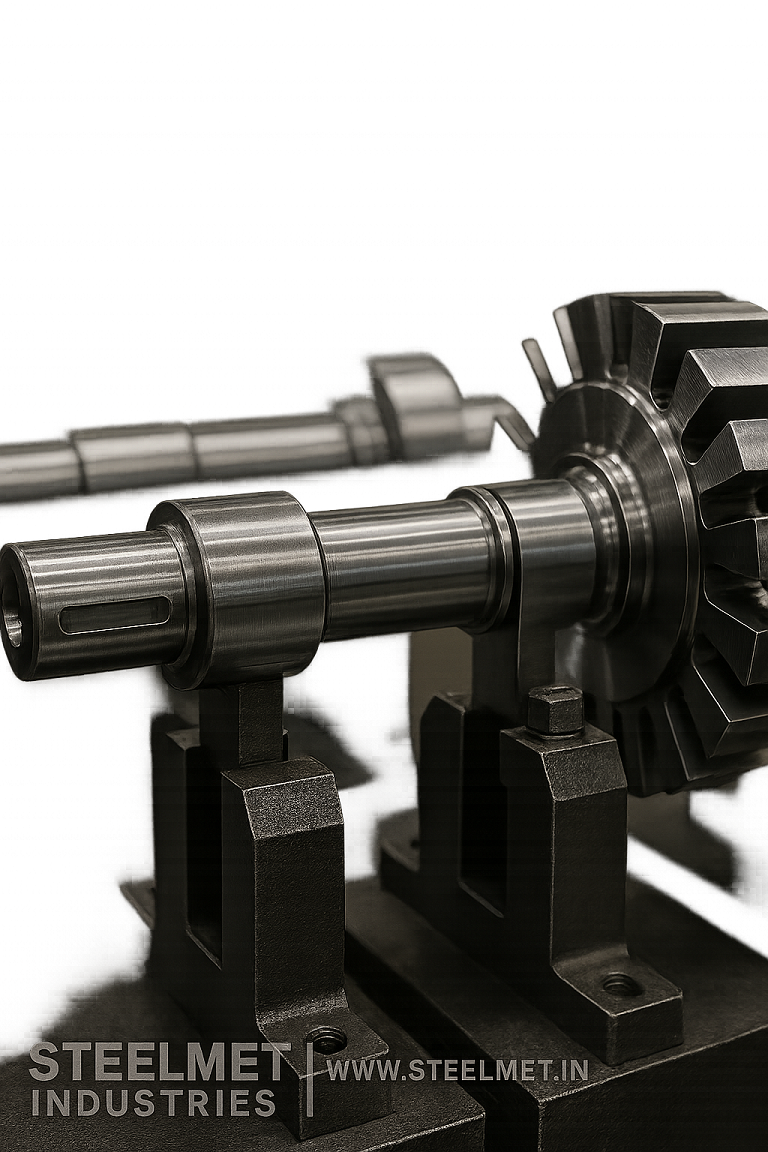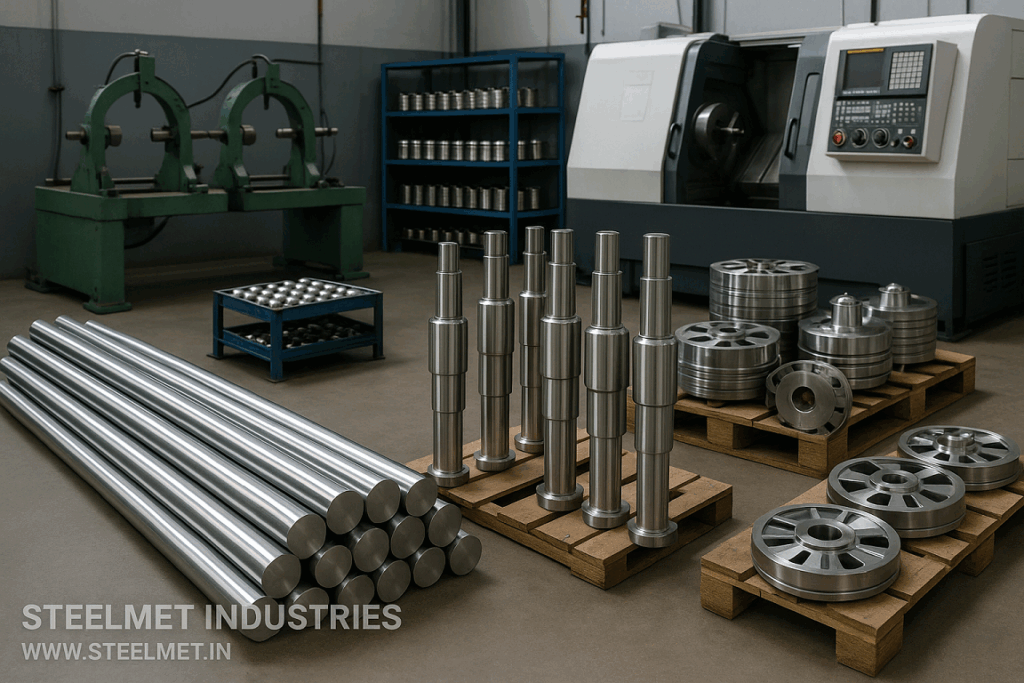Bright Steel Bars for Electric Motor Parts
Electric motors demand components that maintain dimensional stability, balance and fatigue strength under continuous rotation. Bright steel bars provide the required straightness, uniform diameter, clean surface condition and metallurgical consistency needed for shafts, rotors, spindles and precision-fit assemblies used in industrial, automotive and HVAC motors.

Bright bars prepared for machining into electric motor shafts, rotor spindles and precision assemblies.
Primary Electric Motor Applications
- Electric motor shafts (single-shaft and double-end)
- Rotor shafts, stator shafts and spindle elements
- Pump motor drive shafts
- HVAC blower shafts and fan motor components
- Servo motor shafts and high-speed motor elements
- Clutch hubs, couplings and precision-fit motor hardware
Component Types & Application Characteristics
Motor Shafts & Spindles
Electric motor shafts require tight straightness control and uniform mass distribution to achieve proper dynamic balance. Surface finish and OD precision are critical to avoid bearing vibration and noise.
Rotor Shafts
Rotor shafts experience cyclic torsional loads and require controlled microstructure for reliable performance. Bright bars support reliable press fits, reduced machining allowance and consistent magnetic performance.
Couplings & Auxiliary Components
Couplings and motor hardware rely on accurate OD and ID tolerances to ensure proper alignment between motor and load, reducing vibration and increasing bearing life.
Why bright steel bars improve electric motor performance
- Superior straightness and roundness minimise dynamic imbalance and reduce vibration.
- Uniform surface finish enhances bearing and seal life in high-speed motors.
- Consistent microstructure supports uniform heat-treatment response for fatigue-critical parts.
- Reduced machining allowance lowers heat generation during machining and improves cycle consistency.
- Excellent compatibility with grinding, balancing and press-fit operations.
Real-world use case
Example: A motor manufacturer producing high-speed blower motors switched from hot-rolled bar to bright EN8/C45 shafts. This reduced dynamic balancing corrections and improved shaft surface finish consistency. For servo motors, EN19/4140 bright bars supplied Q&T provided superior fatigue resistance during rapid start–stop cycles.
Quick decision pointers
- For general-purpose electric motor shafts: C45/EN8 provides balanced strength and machinability.
- For high-speed motors and servo shafts: EN19/4140 is preferred for improved fatigue strength and toughness.
- For heavy-duty rotor shafts: EN24/4340 offers deeper hardenability and better high-cycle fatigue resistance.
- For bearing contact areas: EN31/52100 supports high wear resistance and excellent contact fatigue performance.
Failure-prevention and quality notes
- Specify runout and concentricity for shaft journals before and after heat treatment.
- Define OD surface finish (Ra) for bearing zones to avoid premature noise and vibration.
- Ensure straightness limits are included on drawings for longer shafts—critical for balancing.
- Verify microstructural uniformity to avoid magnetic imbalance in high-speed motors and rotors.
- Control chamfer geometry to prevent stress concentration and assembly misalignment.
Standards & Equivalents (Table 1)
| IS | BS970 | AISI / SAE | DIN / EN | JIS | GOST | GB |
|---|---|---|---|---|---|---|
| C45 | EN8 | 1045 | C45E / 1.1191 | S45C | 45 | 45# |
| EN19 | 708M40 | 4140 | 42CrMo4 / 1.7225 | SCM440 | 40Х | 42CrMo |
| EN24 | 817M40 | 4340 | 34CrNiMo6 / 1.6582 | SNCM447 | 40ХН2МА | 34CrNiMo6 |
| EN31 | 070M55 | 52100 | 1.3505 | SUJ2 | ШХ15 | GCr15 |
Grade Selection, Performance & Heat Treatment (Table 2)
| Grade | Typical Application in Electric Motor Components | Performance Indicators | Typical Heat Treatment Route |
|---|---|---|---|
| C45 / EN8 (1045) | Used for general-purpose motor shafts, pump shafts and blower shafts requiring a balance of strength, machinability and good surface finish. | Machinability: Medium | Hardenability: Low/Medium | Wear Resistance: Moderate | Fatigue Strength: Moderate | Normalize or Q&T; induction hardening for bearing journals where required. |
| EN19 (4140 / 42CrMo4) | Used for higher-speed shafts, servo motor elements and components requiring improved fatigue strength during rapid acceleration cycles. | Machinability: Medium | Hardenability: Good | Wear Resistance: High | Fatigue Strength: High | Quench & Temper; induction hardening on load-bearing sections where applicable. |
| EN24 (4340 / 34CrNiMo6) | Ideal for rotor and high-torque motor shafts requiring deep hardenability, high fatigue life and excellent toughness for heavy-duty or industrial applications. | Machinability: Medium/Low | Hardenability: Excellent | Wear Resistance: Very High | Fatigue Strength: Very High | Quench & Temper; sub-zero treatments may be used for critical fatigue applications. |
| EN31 / 52100 | Suited for bearing zones, precision journal surfaces, and components requiring extremely high wear resistance and excellent contact fatigue strength. | Machinability: Low | Hardenability: Excellent | Wear Resistance: Very High | Fatigue Strength: Very High | Through-hardening and tempering; controlled cycles for bearing-grade performance. |
Inspection & manufacturing checklist
- Confirm shaft runout and maximum allowed eccentricity before balancing operations.
- Specify surface finish (Ra) for bearing seats and rotor mounting zones.
- Define hardness requirements for journals, rotor fits and keyways.
- Include microstructural requirements for high-speed or high-temperature motors.
- Document press-fit tolerances and allowable deformation limits during assembly.
Frequently Asked Questions
Which grade is most common for electric motor shafts?
C45/EN8 is widely used for standard motors due to its balance of machinability, strength and surface finish quality.
When should EN19 or EN24 be selected?
Use EN19/4140 for higher-speed or fatigue-prone applications. Select EN24/4340 when deep hardenability or superior fatigue strength is required.
How does bright bar quality affect motor balancing?
Straightness, uniform diameter and surface integrity significantly reduce the time needed for balancing and help minimise vibration in assembled motors.
Contact for Electric Motor Component Requirements
For shaft blanks, rotor shaft material, custom machining tolerances or long-term supply of bright steel bars for electric motors:
Related: Bright Steel Bar Applications — Industrial Machinery Components — Hydraulics & Pneumatics

